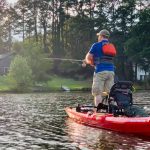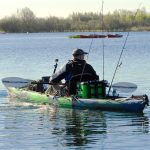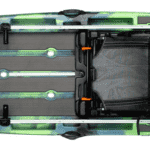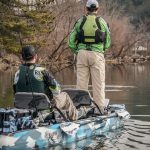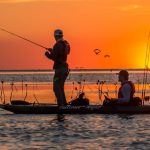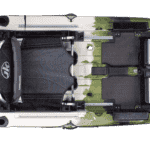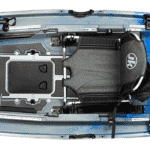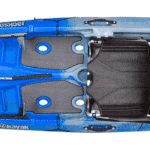When Bonafide set out to design the ultimate fishing kayak, they put in years of research that would ultimately pay off in a big way. When they produced the final product, what they had was a kayak that was laser-focused to have one defining characteristic—Fishability.
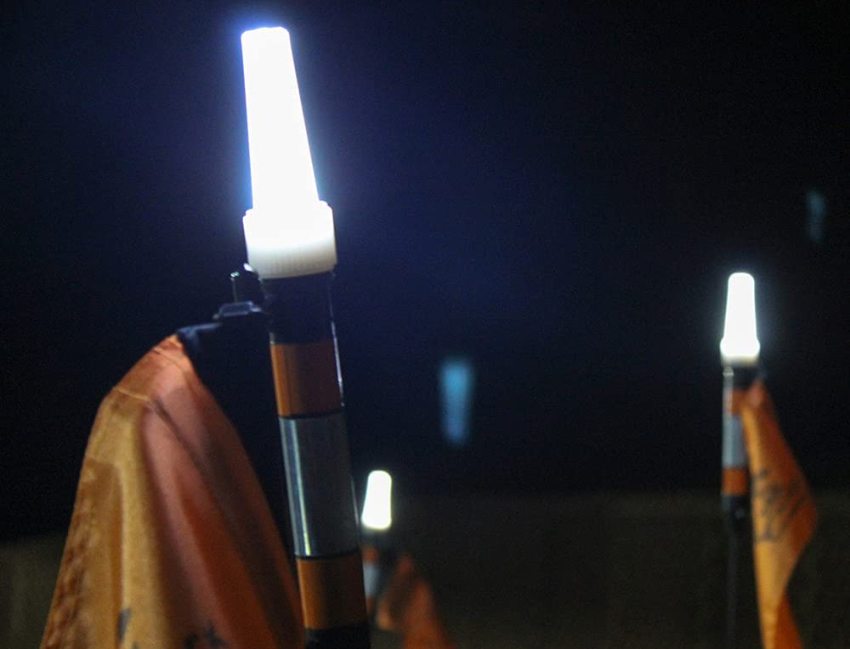
I’ve always loved the idea of a nighttime paddle!
Don’t get me wrong: I’m a huge fan of kayaking when the sun is high, the day is hot, and the water is cool. That’s when most of us paddlers get out on the water and enjoy those beautiful sunny summer days the way they’re intended to be enjoyed.
But night sports are just so much fun, too. When the stars are out, the moon is high, and the world is quiet, being out in nature feels almost magical.
Nighttime kayaking is a truly game-changing experience. It’s a strange mix of exciting, terrifying, and calming all at once.
Really, it’s something everyone should experience at least once in their lives—or, if you’re smart and prepared, on a regular basis.
When it comes to kayaking after dark, there’s really only one piece of additional gear you’ll need: a set of kayak lights.
Truly, that’s it! With a good kayak light, you’ll be safe out on the water and be fully able to enjoy the calm, clear summer nights on the lake, river, or ocean.
Below, I’m going to take a deep dive into all of the best lights for night paddling on the market.
I’ll walk you through the laws and U.S. Coast Guard regulations that govern the use of navigation lights.
I’ll also explain all the ins and outs of buying a kayak light so you can walk away from this article with the best option for your specific kayaking setup.
Trust me, you’ll want to read all the details so you’re fully informed and prepared to safely enjoy those glorious nighttime paddles!
As an affiliate of Amazon and other retailers, we may earn a small commission when you buy via our links, at no additional cost to you. Thank you!
Quick Answer: The Best Kayak Lights for 2023
Don’t have time to read the entire article right now? Don’t sweat it! Bookmark the page and come back to do a deep-dive on the information below at a later date.
For now, just scroll through our condensed list of the best kayak lights for your specific needs:
- Best Overall: Kayalu Kayalite Portable Bright White Led Kayak Light
- Best High-End Option: Guardian Angel
- Best Battery Life: RAILBLAZA Visibility Kit Kayak All-Around Safety Light
- Best with Flag: YakAttack VISIPole II
- Versatile Mounting Options: Attwood 14192-7 Water-Resistant Deck Mount LED Navigation Light Kit
- Best Budget: Paddlers Supply Company LED Kayak Deck Light with Suction Cup Base
- Best Handheld: ENERGIZER Rechargeable LED Spotlight
- Best Clip-On: UST See-Me 1.0 Waterproof LED Light
- Best Bow Light: Innovative Lighting – 560-1110 Portable LED Bow Light
- Best Waterproof Headlamp: Black Diamond Spot 350
Comparison Table: Best Kayak Lights
| Model | Specs | Where to Buy |
 Kayalu Kayalite Portable Bright White Led Kayak Light | Mount Type: Tension strap Waterproofing: IPX8, up to 1,000 feet Battery Life: 100 hours | Amazon |
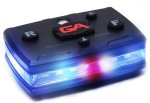 Guardian Angel | Mount Type: Magnetic Waterproofing: IP68 Battery Life: 93 hours | Amazon |
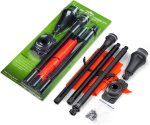 RAILBLAZA Visibility Kit Kayak All-Around Safety Light | Mount Type: Drill-mounted Waterproofing: IP8, up to one meter Battery Life: 200+ hours | Amazon |
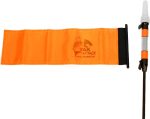 YakAttack VISIPole II | Mount Type: Track Waterproofing: IPX8, up to 1,000 feet Battery Life: 100 hours | Amazon |
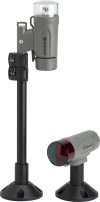 Attwood 14192-7 Water-Resistant Deck Mount LED Navigation Light Kit | Mount Type: Drill-mounted or adhesive Waterproofing: Unspecified Battery Life: 150 hours | Amazon |
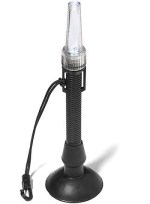 Paddlers Supply Company LED Kayak Deck Light with Suction Cup Base | Mount Type: Suction cup + clip-on Waterproofing: Unspecified Battery Life: 100 hours | Amazon |
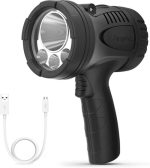 ENERGIZER Rechargeable LED Spotlight | Mount Type: Handheld Waterproofing: IPX4 Battery Life: 4-9 hours | Amazon |
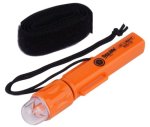 UST See-Me 1.0 Waterproof LED Light | Mount Type: Lanyard Waterproofing: IPX7, immersion up to 1 meter Battery Life: 17 hours | Amazon |
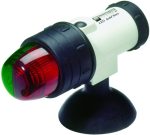 Innovative Lighting – 560-1110 Portable LED Bow Light | Mount Type: Suction Waterproofing: Unspecified Battery Life: Unspecified | Amazon |
 Black Diamond Spot 350 | Mount Type: Headlamp Waterproofing: IPX8, submersible up to 1.1 meters for 30 minutes Battery Life: up to 200 hours | Amazon |
Our List of the Top-Rated Kayak Lights: All the Details You Need to Know
Best Overall: Kayalu Kayalite Portable Bright White Led Kayak Light

Mount Type: Tension strap
Waterproofing: IPX8, up to 1,000 feet
Battery Life: 100 hours
This kayak light kit is designed to be visible from all sides, with a 360-degree radius of illumination that will make you easy to spot from every direction. With around 100 hours of battery life (using 3 AA batteries), it will keep you safe and make you easily visible all night long.
The white light is mounted atop an 18-inch pole, which you can secure to your kayak deck using a tension strap. This makes it far less breakable and harder to lose than a suction cup or drill-mounted light, and it can be knocked over without damaging your kayak or the light itself. Thanks to the sturdy marine-grade metal used for the pole, it’s one of the most durable lights on the market.
One cool feature: if you don’t have anywhere to clip the light onto your deck, you can purchase a deck-mounting kit separately and secure it using easily installable hardware. It’s one of the most versatile lights on our list, as well as one of the best-performing and most reliable!
Pros:
- Highly durable; will never bend or break
- Fully buoyant and waterproof
- Diffusion lens reduces glare for you and fellow paddlers
- Light visible up to 2 miles away
- Submersible up to 1,000 feet
Cons:
- May overheat if batteries aren’t placed correctly
- Your body may block the light from being seen by anyone in front of you
Best High-End Option: Guardian Angel
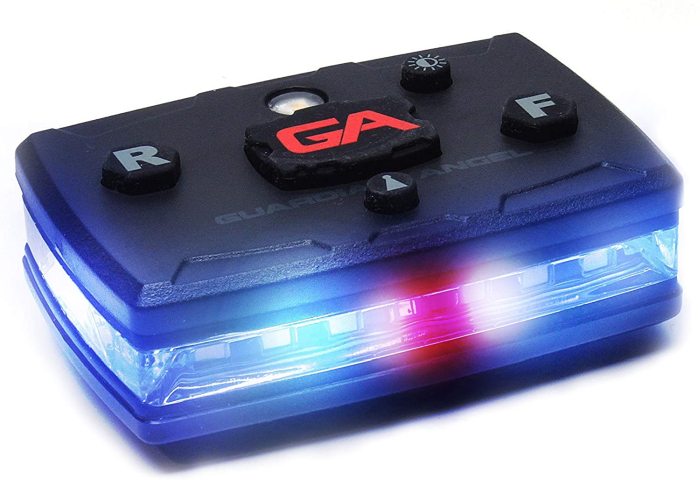
Mount Type: Magnetic
Waterproofing: IP68
Battery Life: 93 hours
This is a truly unique kayak light! Instead of using a clip to slide onto your PFD, it uses two powerful neodymium magnets to stick the light to your lifejacket, coat, shirt, or even the kayak deck itself. It’s compact enough to fit in the palm of your hand, weighs just 3 ounces, but generates enough light to be seen from 5 miles away. Talk about bright!
The Guardian Angel is made with an ultra-tough polycarbonate plastic shell that is IP68 rated (waterproof and dust-proof). It’s not intended to be submerged, but it won’t get waterlogged or damaged should you capsize or have to swim back to shore.
The little device comes with top- and rear-facing ultra-bright LEDs, as well as flashing emergency and work lights. All of those operate independently of each other and are controlled via the device’s single user-friendly button.
The built-in lithium-ion battery pack will give you roughly 93 hours of continuous runtime.
Though it’s pricier and more compact than most of our other top picks, the Guardian Angel is a truly game-changing kayak light that you’d do well to consider.
Pros:
- Highly visible LED lights in a wide array of colors, including yellow, green, blue, white, and red
- Compact, lightweight, and ultra-portable
- Shock-proof, waterproof little device you can take anywhere
- Up to 500 lumens of light output
- Charges in 2-8 hours
Cons:
- Pricey
- Won’t be visible to people behind you if clipped onto your PFD
Best Battery Life: RAILBLAZA Visibility Kit Kayak All Around Safety Light
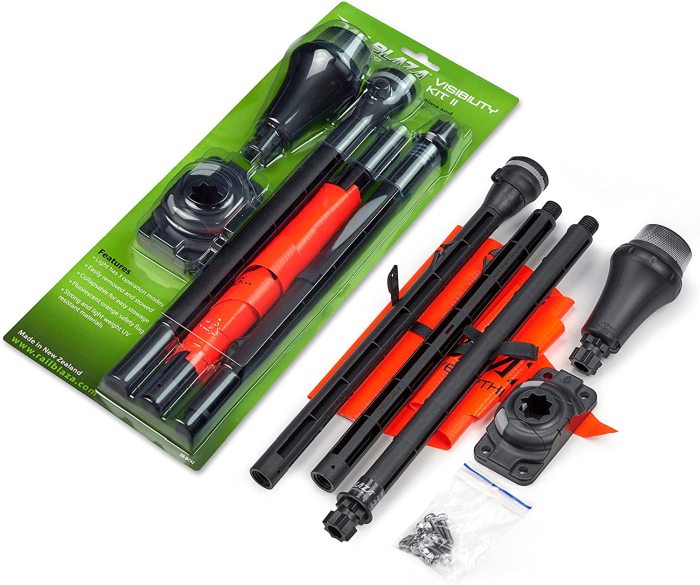
Mount Type: Drill-mounted
Waterproofing: IP8, up to one meter
Battery Life: 200+ hours
This full-visibility mounting kit provides a lot of different options to keep you safe at night! It includes a 360-degree LED stern light and an orange flag to make you more visible during the night and the day. An extendable 3’ pole will raise the light above the level of your head so everyone can see you from all directions.
The battery will last up to 200 hours in flashing emergency mode, up to 160 hours in low brightness work mode, or up to 25 hours in full brightness navigation mode.
The light kit utilizes 3 AA batteries (not included). The fastening pack makes it easy to drill-mount the hardware to your deck. Once installed, you can easily add or remove the light’s pole (unscrewing it from the mounted base) according to your needs.
Bonus: If you already have gear tracks installed on your kayak, you can buy an additional track mount so there’s no need to drill into your kayak.
Pros:
- Adjustable pole (up to 3’) makes the light visible from all directions
- Made in New Zealand, highly durable and good quality
- Includes a flag and drill-mounting hardware
- Decent battery life, great LED light lifespan
- Floats light-side up
Cons:
- Requires holes drilled into your kayak (unless you have gear tracks)
- On the pricier side
Best with Flag: YakAttack VISIPole II
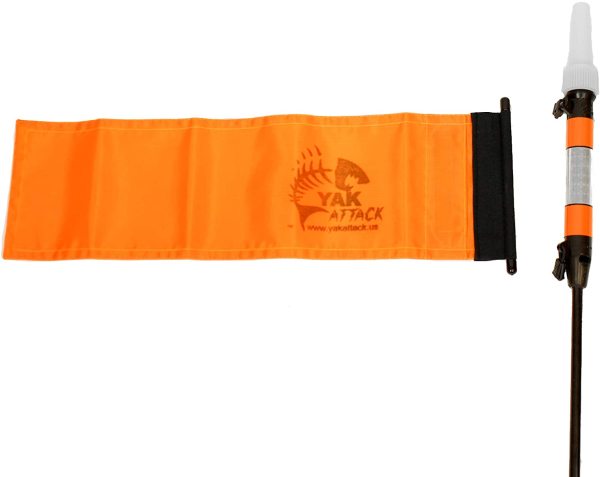
Mount Type: Track
Waterproofing: IPX8, up to 1,000 feet
Battery Life: 100 hours
If you want compact and lightweight, you’ll love this flag and light combo. The super-bright LED light bulb is mounted atop a 3/8” thick fiberglass mast, right above the high-vis orange flag. The height is adjustable up to 4 feet tall, and the mast is tough enough to bend without snapping.
The battery life is around 100 hours, with 3 AA batteries (not included) for the power source. The LED light gets around 10,000 hours of life (pretty standard for LED bulbs) but generates a surprisingly bright light for such a compact size.
The light kit is track-mounted, so if you don’t already have gear tracks installed, you’ll need to buy and add them first. It’s only compatible with GearTrac and MightyMount, though.
Pros:
- Lightweight, slim, and easy to operate
- Carbon fiberglass mast is incredibly durable
- Mast adjustable between 14 and 48 inches
- 360-degree visibility
- Good LED bulb and battery life
Cons:
- Can only be mounted on MightyMount and GearTrac mounts
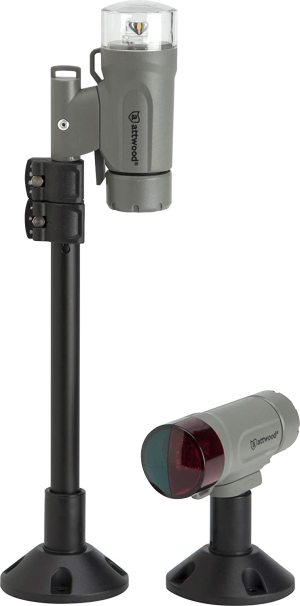
Mount Type: Drill-mounted or adhesive
Waterproofing: Unspecified
Battery Life: 150 hours
This particular Attwood light kit provides you with two lighting options: a mast-mounted white stern light and a shorter bow red/green light. It complies with the safety regulations for boats up to 23’, and it’s absolutely perfect for a kayaker who intends to paddle around a lot of larger motorized boats and sailboats.
Running on 3 AAA batteries (each device), the lights have a runtime of around 150 hours on the standard setting. The electronics are sealed in a sturdy shock-proof metal housing, and the LED light bulbs are protected by a shatterproof polycarbonate lens. There is no information available on a specific IP rating, but reviews suggest that it’s not fully waterproof.
The lights both come with 3M VHB adhesive pads that are perfect for sticking to your deck even when the weather turns rough and wet, but you can also use the provided hardware to drill-mount it to your kayak if you want a sturdier solution. Weighing just 6.4 ounces combined, they’re an extremely lightweight and user-friendly option!
Pros:
- Multiple mounting options—drill or stick them to your deck
- White and red/green lights provided
- Great for kayaks, canoes, and larger boats
- Sturdy hardware, well-designed
- Excellent price tag
Cons:
- Not fully waterproof
- Not very bright
Best Budget: Paddlers Supply Company LED Kayak Deck Light with Suction Cup Base
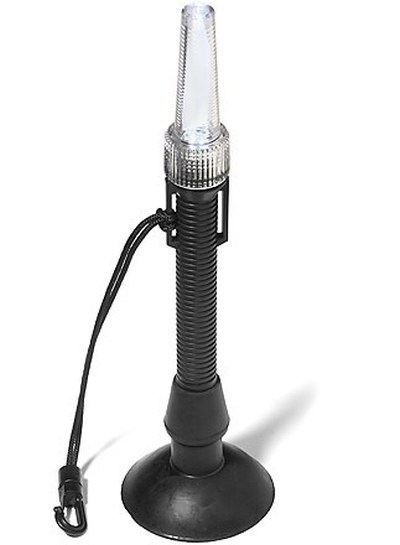
Mount Type: Suction cup + clip-on
Waterproofing: Unspecified
Battery Life: 100 hours
If you want to go cheap but still get good quality, this is the best kayak light for you, hands down. It’s the most affordable option on our list, but it doesn’t sacrifice durability or reliability just to keep costs low.
This deck mount LED navigation light is visible up to 2 miles away, with a battery life of around 100 hours. Though there is no official IP rating available, it claims to be waterproof and leakproof up to 1,000 feet underwater (the equivalent of an IPX8 rating). The flare-style end produces a highly visible light that is bright enough to alert even larger boats to your presence.
The suction cup base makes it easy to stick this light in place on your kayak, but some reviewers complain that after 2-3 years, the rubber stops working and begins to crack. Thankfully, you can always remove the light from the mast and clip it to your PFD using the attached hook lanyard. Now that’s convenience at its best!
Pros:
- Can be suction-mounted or clipped to PFD
- Highly durable, waterproof, and leakproof
- Ultra-bright flare-style light
- Excellent pricing
Cons:
- Suction cup rubber will crack and lose adhesion power over time
- Doesn’t float
Best Handheld: ENERGIZER Rechargeable LED Spotlight
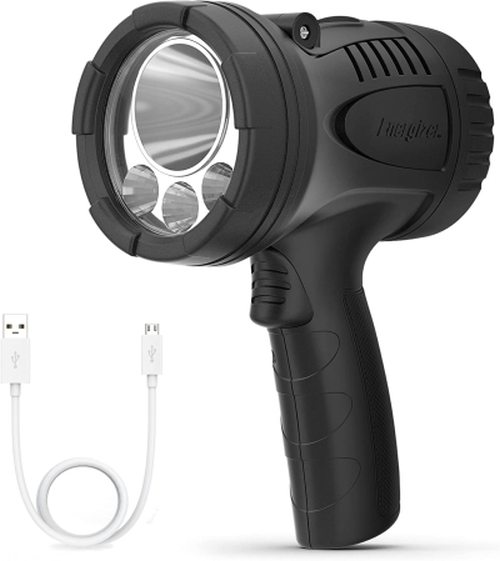
Mount Type: Handheld
Waterproofing: IPX4
Battery Life: 4-9 hours
This is the ideal spotlight for you to take with you on any boat, kayak or canoe. It’s ultra-bright with an output of 300-6000 lumens, with a beam that reaches over 1,000 feet. Though it’s not the longest-lasting light source—just 4 hours on max output, or 9 hours on low setting—it’ll be just what you need to locate any hazards in the water or identify yourself to passing vessels.
The spotlight uses a hyper-durable LED light bulb housed in a rugged plastic body. It’s waterproof up to 3 feet, impact-resistant, and will shine through fog or rain. Thanks to its oversized buttons, it’s easy to operate even with cold hands or if wearing gloves.
Pros:
- Ultra-bright and hyper-durable spotlight
- Reliable and versatile
- Decent waterproofing rating; highly impact resistant
- Shines through bad weather
- Excellent spotlight beam length
Cons:
- No instructions manual included
- Battery life may be shorter than claimed (one user said around 2 hours on max output)
Best Clip-On: UST See-Me 1.0 Waterproof LED Light
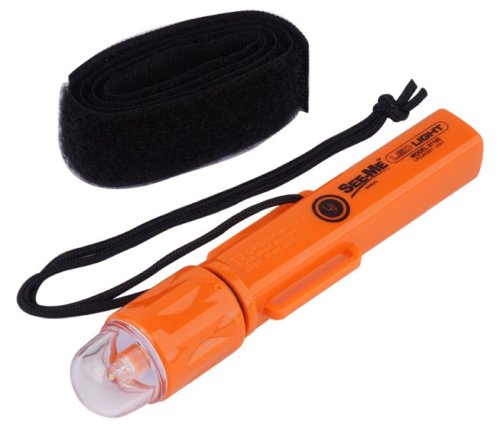
Mount Type: Lanyard
Waterproofing: IPX7, immersion up to 1 meter
Battery Life: 17 hours
This is definitely not the brightest or longest-lasting of the lights on our list, but it’s a handy backup plan to have in case your primary light source fails, runs out of power, or gets damaged by water. This ultra-tough little LED safety light will be your emergency plan to stay safe or get rescued should things take a turn for the worse.
It doesn’t come with any clips, but it’s small enough to fit into the straps of your PFD and designed to stay securely in place no matter how hard you row. Just for safety’s sake, you can always tie it to your PFD using the accompanying lanyard. If it does slip out, it’ll just dangle from the lanyard, within easy reach should you need it.
The twist-on/off operation is incredibly easy, and it’s visible up to 3.4 miles away on a clear night. With an IPX7 rating, it’s waterproof up to 1 meter underwater. Best of all, it weighs less than 2 ounces and gets up to 17 hours of runtime with just 2 AA batteries.
Pros:
- Compact and extremely lightweight
- Slides into your PFD and can be tied with the lanyard
- Easy operation; ultra-reliable
- Unbreakable LED light bulb
- Very affordable
Cons:
- Not very bright
- If operated incorrectly (twisting the top the wrong way), it will pop open the battery compartment, potentially risking getting water-damaged
Best Bow Light: Innovative Lighting – 560-1110 Portable LED Bow Light
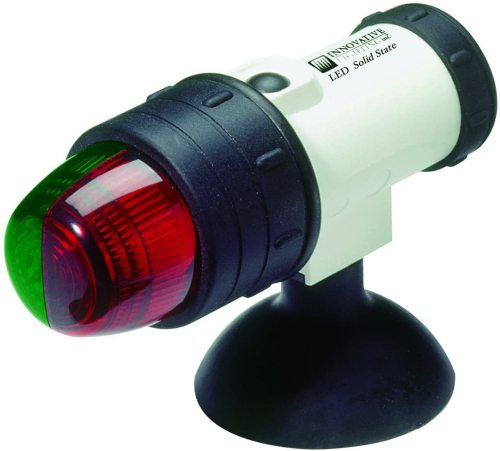
Mount Type: Suction
Waterproofing: Unspecified
Battery Life: Unspecified
If you’ve already got a stern mast-mounted light, this is an extra addition to maximize visibility to anyone in front of your kayak. It’s designed with a simple suction cup that mounts easily to the bow of your kayak in seconds, and the one-piece body is reliably water-resistant and durable should you capsize or crash.
The LED light bulb has a lifespan of around 100,000 hours, and running on 4 AA batteries (not included) it gives at least 15+ hours of battery life (according to one user review). It provides both the red and green light to warn passing watercraft of your port and starboard sides—great for complying with U.S. Coast Guard regulations.
Pros:
- Sealed heavy-duty on/off switch can be safely operated in wet conditions
- Compact and lightweight
- Easily mounted
- Fairly inexpensive
- Waterproof and buoyant
Cons:
- Limited technical information available
- Suction isn’t very secure
Best Waterproof Headlamp: Black Diamond Spot 350
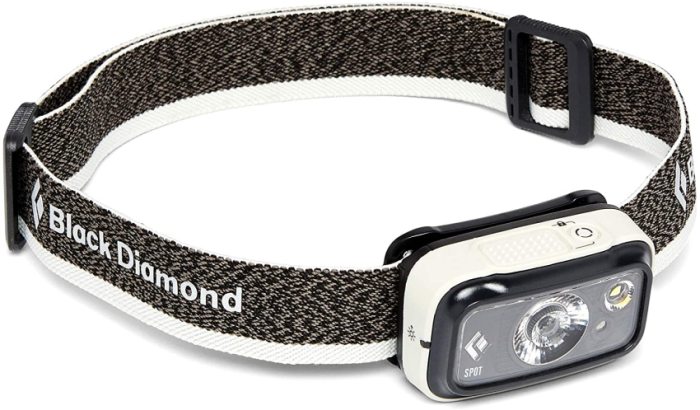
Mount Type: Headlamp
Waterproofing: IPX8, submersible up to 1.1 meters for 30 minutes
Battery Life: up to 200 hours
If you want to enjoy some hands-free paddling without having to deal with the hassle of installing kayak lights, this waterproof headlamp is just the thing for you. With an IPX8 rating, it can spend up to 30 minutes submerged up to 1.1 meters underwater—and it’s definitely more than capable of handling any amount of rain.
The headlamp runs on 3 AAA batteries (included in the box) and delivers a runtime ranging from 3.75 hours (on floodlight setting) to 200 hours (on the lowest setting). The beam extends up to 86 meters on max setting or just 8 meters on the lowest setting, allowing you to decide just how bright a light you want to cast. Best of all, the “brightness memory” setting will let you switch the light off and retain your last brightness setting.
It’s the ultimate headlamp for kayakers, hunters, fishermen, and campers!
Pros:
- Excellent brightness, multiple settings
- Superior battery life
- Good IPX8 waterproofing
- Comfortable to wear even after long hours of use
- Compact yet surprisingly sturdy
Cons:
- Small buttons may be hard to operate with cold hands or when wearing gloves
- Red light is weak
Buying Kayak Lights: What You Need to Know
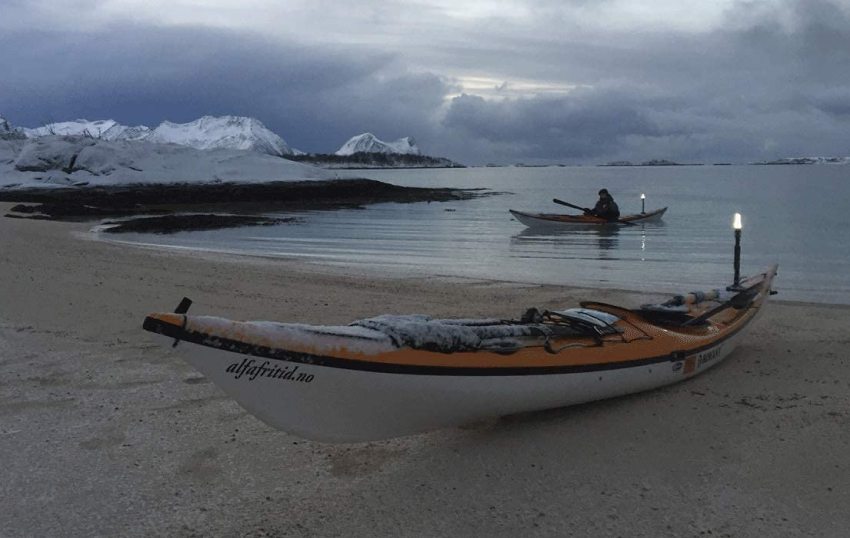
Why You Need Lights on Your Kayak
For anyone planning to enjoy an after-dark kayaking adventure, kayak lights are an absolute must. They serve two very specific purposes:
If you’re paddling on a night with very little light from the moon or stars, it can be tough to see where you’re going or what obstacles might be in your way.
RELATED: When GPS Fails: Best Kayak Compass in 2023
This isn’t a huge problem when you’re out in the middle of a lake, but what if you’re near the shore or traveling downstream?
Kayak lights are very useful for helping you see where you’re going and avoid any obstacles or dangers that could put you or your kayak at risk.
Safety
Kayaks are small vessels typically without a motor. This makes them both hard to see and even harder to hear.
Kayak lights will make you visible to other watercraft (boats, fellow kayakers, paddleboarders, ships, etc.) so they can safely avoid collisions.
The truth is that Reason #2 is actually far more important than Reason #1!
If you’re lucky enough to kayak in a city (Vancouver, Austin, San Francisco, Chicago, Oklahoma City, etc.), you’ll have all the city lights to illuminate your path. If you’re paddling out in the middle of a lake in a national park, there are no lights around, but the stars and moon are typically enough to illuminate your surroundings—once your eyes adapt to the darkness, of course.
Really, you only need a light source once you’re getting near shore, helping you to avoid obstacles (strainers, sweepers, fallen trees, and the shoreline itself), or if you’re navigating up or down a river.
The biggest dangers you will face out on the water—especially on the ocean and popular lakes—are from other watercraft. You run the risk of a collision if you can’t see other boaters, or a passing boat may see you just in time to avoid a collision, but pass so close that it tips you over.
In truth, kayak lights are mostly a safety feature, just like PFD or your bailing kit. They’re a way to make sure you’re safe from other vessels when out on the water.
Kayak Lights Regulations and Rules
Boats are required by the U.S. Coast Guard to display a variety of lights—including a red light on the port side, a green light on the starboard side, and white lights on both the bow (front) and stern (back). However, this applied to motorized vessels and sailboats.
Kayaks are classified as “vessels under oars”. They are not required to have the same deck-mounted lights as larger vessels, but they are required to have either an electric flashlight or lighted lantern with white light that they exhibit “in sufficient time to prevent collision”.
Basically, you need SOME form of bright white light on board your kayak if you want to paddle at night. Flashlight, headlamp, or the typical stern/bow/side lights—these are all suitable options to consider for your kayak.
Note: It is also required to carry Visual Distress Signals (like a pyrotechnic flare) if you’re going to be out on the water at night. Larger vessels need it during the daytime, but kayaks only need to have them for nighttime paddling.
Though the requirements don’t demand that you use full lighting systems like larger vessels do, I believe it’s smart to consider going for maximum visibility when paddling at night.
It’s safer for both you and other watercraft that might be sharing your waters. Anything that helps you avoid collisions or accidents is definitely a good idea in my books!
The Ultimate Guide to Choosing Kayak Lights
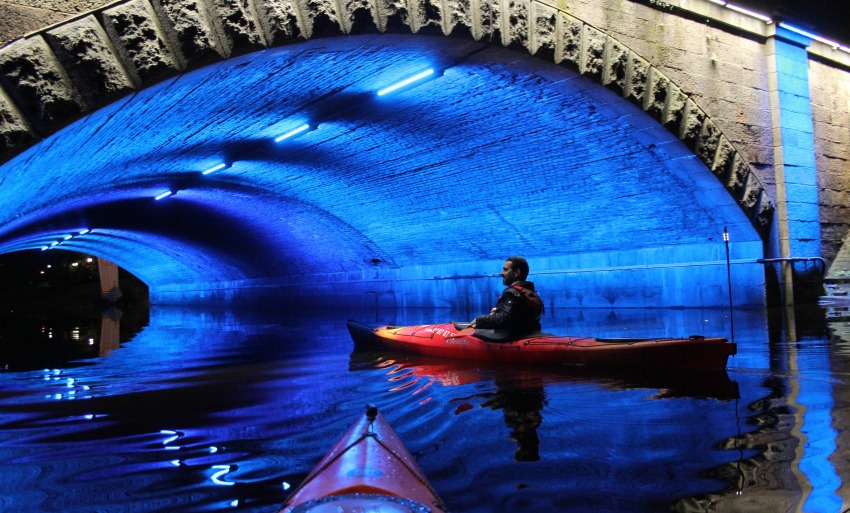
Let’s dive into what you need to know about choosing the best kayak lights. As you’ve seen from our list above, there are a lot of options to select from, with different designs, features, and functions. It’s important to know what purpose each serves so you can choose the lighting option that best suits your needs.
Types of Kayak Lights
There are basically four types of kayak lights to consider:
Handheld Lights
Handheld flashlights and spotlights are pretty standard fare for fishermen and boaters. You can find an impressively wide array of boat spotlights and ultra-bright LED flashlights available today.
However, there aren’t too many that offer the hardcore waterproofing needed to protect the flashlight in case it falls overboard or your kayak tips. Also, you have to hold the flashlight, meaning you can’t shine the light and paddle at the same time.
Helmet Lights and Headlamps
Headlamps are popular among hunters, fishermen, hikers, snowboarders, snowshoers, skiers, and others who enjoy being outdoors at nighttime. They’re small, compact, and totally hands-free. Some you wear directly on your head (with an elastic band to keep it in place), while others are clipped or mounted to a helmet. A headlamp is super convenient for kayak fishing in low light.
The downsides of headlamps and helmet-mounted flashlights are:
- They’re not always very waterproof
- They may slip off your head/helmet if you capsize
- They’re not the brightest light source.
Clip-on Lights
Clip-on lights are usually compact flashlights that you can secure to your PFD using a carabiner or clip. These are also beautifully hands-free and easily accessible—you’ll never have to fumble around the kayak cockpit to fit them because they’re clipped right to your lifejacket.
However, the fact that they’re so small means they won’t generate a lot of light, making them far less visible than the other lighting options.
Deck-Mounted Lights
Boats typically come with navigation lights that are mounted to their decks and hulls. A number of kayak lights are designed in the same way. These lights are typically secured to the deck itself and operate on their own battery power (rather than connected to a boat motor or battery).
How Do You Mount Lights on a Kayak?
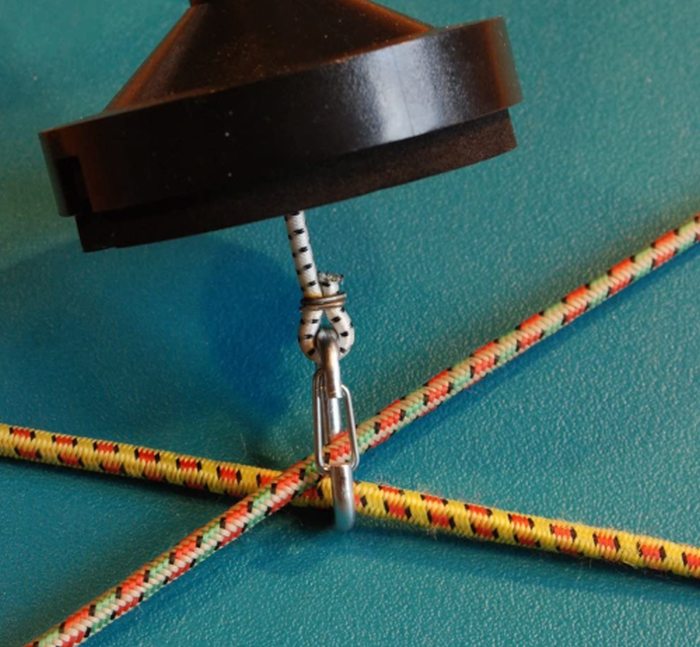
There are five basic mounting options available:
Clamp-on
This type of mount is basically an oversized metal C-clamp that you secure to your kayak. Given the shape of most kayak hulls, it’s typically best-suited for sit-on-top kayaks. These mounts are typically heavy-duty and, once secured, are very unlikely to slip or shift. However, they’re heavy, unwieldy, can only be mounted in very specific spots on your kayak, and may actually damage the hull if over-tightened.
Suction Cup
This is a more “modern” option that has become ultra-popular in the last few years. Suction mounts use a dense rubber cup that creates suction when applied to the hull, sticking in place without the need for a heavier, bulkier mounting system. However, be aware that the suction cup needs a clean, smooth surface to adhere to. If your kayak is dirty, dented, or scratched, it may not provide the most secure hold.
Tension Cable
Tension cables are designed to clip onto eyelets or D-rings integrated into the kayak’s deck. The clip is actually built into the base of the light, allowing it to sway slightly and bend over as needed. This is one of the more convenient mounting options, provided your deck has some mounting hardware to clip the light to. However, if it’s not pulled tight, you might find yourself constantly picking up a light that tips over in choppy waters.
Track Mount
More and more kayaks (especially fishing kayaks) are equipped with gear tracks that allow you to install additional hardware and accessories securely onto the deck. A number of kayak lights are designed to be mounted on the kayak’s gear tracks. These offer a very secure and convenient mounting option, but are only useful if your kayak has gear tracks—and, in some cases, only a specific type of gear track.
Drill Mount
Like with many other kayak accessories, sometimes it’s best just to drill right into the deck or hull for the most secure mounting. Drill-mounted lights typically use screw-down mounting plates that are bolted directly to your kayak. They are the most secure option around, but you have to be comfortable drilling holes in your kayak. Once mounted, they’re not adjustable, so you have to make sure you get it right on the first try.
What You Need to Know About Kayak Light Bulbs
It’s safe to say that 99% of modern kayak lights will use LEDs (light-emitting diodes) to generate light.
LED lights are highly energy-efficient. They give off less heat, use less electricity, but generate a LOT more light. They also tend to have a longer lifespan and be far more resistant to damage than other lighting options. And, of course, they end up being significantly cheaper to operate in the long run.
Most kayak lights are a simple LED light bulb attached to a combination of:
- Mounting system (as explained above)
- A power source (rechargeable or regular AA/AAA batteries)
- A pole to raise it above the water to increase visibility
However, there are a few options that include more advanced lighting features. This includes:
Diffusion Lens – A diffusion lens “diffuses” or scatters the light generated by your LED. Or, to put it another way, it softens the light without diminishing brightness. It won’t impair the visibility of your kayak light—on the contrary, it will actually increase the glow by spreading it out across a wider surface (the surface of the lens)—but it will make the light less blinding to other vessels or paddlers nearby.
Spotlight – A spotlight is the exact opposite of a diffusion lens. Instead of softening the light, spotlights amplify illumination by producing a cone of light that is tightly focused on a smaller area. They are ultra-powerful and ultra-bright, perfect for fishing, boating, or hunting in dark environments where you need to light a specific patch of water or shoreline.
Neither of these is critical for safe nighttime kayaking. However, they may come in handy depending on your circumstances.
Guide to Kayak Light Waterproofing
One critical factor in kayak lights—really, in all kayak gear—is waterproofing. After all, it’s going to be on, around, and possibly in the water, so it needs to be able to withstand getting wet or even falling overboard.
On any waterproof product, you’ll see an “IP rating” (like IPX8 or IP65). These ratings can seem a bit confusing, but they’re actually fairly simple.
Let me break it down for you:
- IP stands for “Ingress Protection”
- The first numeral or letter details the “Solid Particle Protection” (dust, dirt, etc.)
- The second numeral or letter details the “Liquid Ingress Protection” (including water).
So, let’s take a look at the IP ratings on one of the products we’ve included on our list.
Our Best Overall pick, the Kayalu Kayalite Portable Bright White Led Kayak Light, has an IPX8 rating.
- The “X” means there is no protection rating specified—in this case, there’s no protection against solid particle ingress (not that it’s needed because it’s going to be used chiefly on water).
- The “8” means it’s protected against “Immersion beyond 1m”. The depth of immersion is then specified by the manufacturer—in this case, up to 1,000 feet.
See how easy that is? You can easily find the complete IP Rating Chart to help you know what level of waterproofing your kayak lights have at a glance. The higher the IP rating (particularly the second numeral), the better the waterproofing!
Choosing Kayak Lights for Night Paddling: Factors to Consider
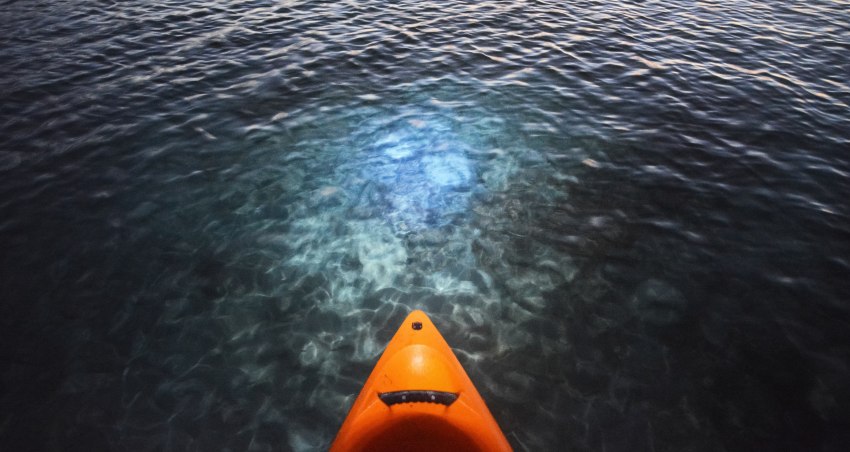
If you’re looking into buying kayak lights, there are a few things you need to consider:
Mounting Options
We explained the mounting options above, along with the various pros and cons of each.
C-clamps may only be compatible with certain deck shapes.
Suction cups may not work on kayaks that are very dirty or damaged.
Track-mounted lights are only useful if you have existing gear tracks (or plan to install them yourself).
Drill-mounting your lights may damage your hull.
Consider which of these options you’re most comfortable with, and shop accordingly.
Light Output
Just remember: the higher the lumens, the brighter and more visible the light. However, powerful lights tend to be heavier and consume more energy.
Visibility Distance
Some kayak light manufacturers will opt for sharing how far away the light can be seen rather than detailing the lumen output. This is another good way to know just how visible the lights will be out on the water after dark.
Power Source
All kayak lights will be battery-powered, either with AA/AAA batteries or a built-in rechargeable battery.
Built-in batteries are convenient and eco-friendly but may be not enough on longer multi-day trips. They are also more expensive to replace if damaged, defective, or if they simply give out on you.
AA/AAA battery-powered devices are typically more expensive to operate, but there is the risk that opening the battery compartment to change the batteries could allow water to seep in (if you have to change batteries mid-paddle) and destroy the power supply.
Battery Life
This is definitely a critical factor to consider!
You certainly don’t want to have to change batteries mid-paddle just because your light ran out of juice—it’s both inconvenient and potentially dangerous.
Thankfully, you can find lights that last 100+ hours and can be easily re-charged between kayaking trips to make sure they’re always topped up.
Durability
LED lights are fairly durable, but the rest of the light may be prone to breaking or deterioration. Plastic is fully waterproof and lightweight, while marine-grade metal is far sturdier and more damage-resistant.
Size
A bulky, over-large kayak light will be a pain in the rear to install, and it may actually be annoyingly in the center of your view as you’re trying to enjoy your nighttime paddle.
On the other hand, a light that is too small will be harder for passing vessels to see, which could be dangerous.
Weight
The last thing you want is to add a lot of unnecessary weight to your already-loaded kayak. C-clamps and marine-grade metal light housings tend to be heavy and bulky compared to plastic light housings and suction cups or track mounts.
Smart Tips for Safe Kayak Light Use
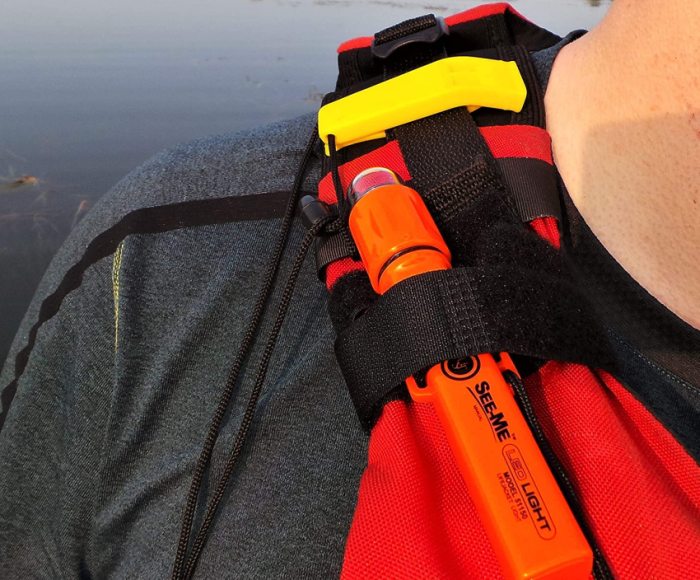
If you’re going to hit the water, here are some tips to help you be smart with your kayak light:
Bring extra batteries in a waterproof bag. You’ll never regret having a set of backup batteries or a replacement power pack in your dry bag should the light crap out mid-paddle.
It’s well worth carrying around an extra ounce or two of weight!
Test to make sure it’s working before you hit the water. A smart kayaker will always check their gear before loading up, and again before getting out on the water.
Just like you’ll give your PFD, dry bag, and other accessories a once-over, make sure to check the kayak light.
Switch it on to make sure it’s working, and pay attention to any hint of flickering or dimming that could indicate low power or malfunction.
Rinse the light off with fresh water. If you’re kayaking on the ocean or in salt water, make a point of rinsing off the light with fresh water after every use.
Salt can seep into the power source and corrode it. A quick rinse-off will eliminate any salt residue and extend the light’s lifespan significantly.
Store without batteries. Once you’re back at home, pull the batteries or battery pack out of the kayak light and store them separately.
That will prevent any battery drain that could cause you to run out of juice at the worst possible time.
Charge the light regularly. Don’t wait until your batteries or power back run out of power completely. Make it a point to recharge on a regular basis—once a week during peak paddling season, and once every month during the off-season. That way, you’ll always be confident that your light is powered up and ready for a night trip.
How to Kayak Safely at Night
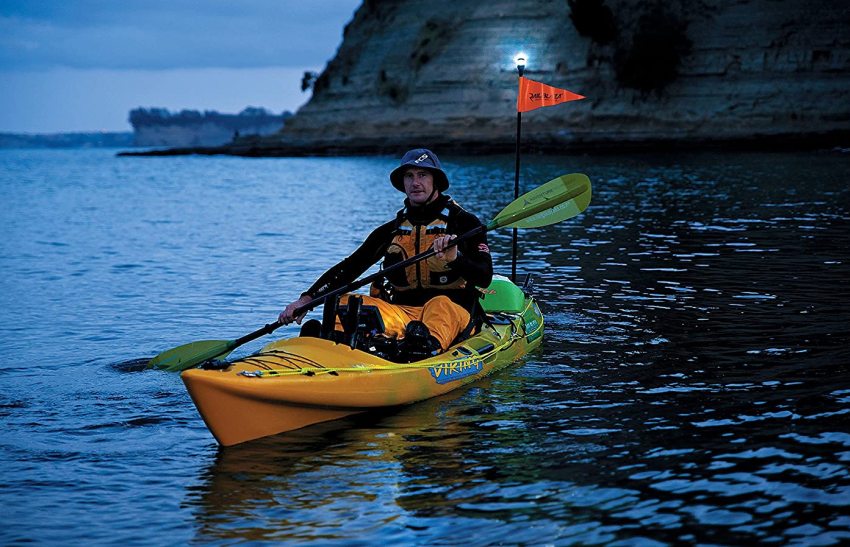
For those who plan to get out on the water at night, safety is an absolute MUST!
To stay safe after dark:
● Plan ahead. Make sure you know your route, the rough time frame for your trip, and how to get back to your vehicle in case you can’t return to your launch point. Make sure others know your plan, too. And again, I can’t overstate the importance of giving all of your kayaking equipment a thorough once-over before heading out on the water!
● Check the weather. Make sure you know if that cloud cover is going to turn to rain or a proper thunderstorm, or if the temperature will plummet while you’re out on the water. Check the weather forecast throughout the day, and again just before you head out in case of any last-minute unpredictable changes.
● Prepare for cold and darkness. Bring extra-warm clothing and waterproof shoes in case the temperature drops unexpectedly. And even if it’s supposed to be a perfectly clear sky, plan for clouds to roll in by bringing an extra flashlight or spotlight in addition to your standard kayak lights.
● Be visible. Visibility is an absolute must when out on the water, especially if you’re sharing that water with other vessels and boats. Don’t just settle for one small kayak light, but consider using a flag, high-visibility clothing, high-visibility PFD, and even additional flashing lights that will make sure everyone around can see you.
● Stick to familiar waters. Night kayaking is not the time to take risks and venture somewhere new. You may run into unforeseen trouble or crash into hazards that would have been easy to see and avoid in the daytime, but which become life-threatening dangers at night. Stick to safe, familiar waters at night and keep your exploring for when the sun is up.
● Watch out for motor-powered vessels and ships. These are likely the greatest dangers you will face during your nighttime paddling. Don’t just make sure they can see you; keep an eye and ear out for them, and steer clear of areas frequented by boats and ships.
It doesn’t take much effort to stay safe when kayaking at night, but even these small precautions will go a long way toward making sure your after-dark paddle doesn’t end up in disaster.
Kayak Lights FAQs
Absolutely! As I explained above, the U.S. Coast Guard only requires that kayakers have some form of flashlight or electric lantern on board. There are no regulations dictating what type of flashlight/lantern you have to carry.
Our friends over at Sea Kayak Explorer have a really cool article on DIY Kayak Lights you can check out if you want to custom-build your own.
Kayakers don’t need any of these lights, only boats do. However, most motorboat operators are accustomed to looking for colored sidelights (red for port side and green for starboard side) as well as white bow and stern lights. If you have all of these lights, it will make you stand out more clearly to passing larger boats.
Red and green navigation lights just highlight which side of the vessel is which so boats know which way to pass you. Kayakers will be fine with just white lights, but you can consider using the red-and-green lights, too, if you’re in an area with a lot of motorized water vessel activity.
This is a cool new trend that has become more popular thanks to the recent availability of LED light strips. You can actually stick the LED light strips to the sides of your kayak and switch them on at night to clearly outline yourself as you’re paddling. Because you don’t have to follow the regulations larger boats and ships do, it’s both perfectly legal and safe to install LED light strips along the sides of your kayak.
That being said, I do recommend ALSO purchasing at least one deck-mounted, handheld, or headlamp-style light for safety. White light always travels the farthest in low-light environments, making it more reliable if you find yourself caught in fog or heavy rain.

